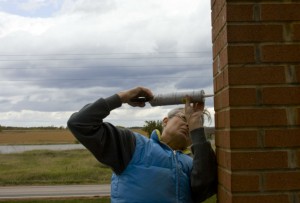Masonry chimneys are quite possibly one of the most overlooked parts of our homes. Small issues are often left untreated (because people have a thousand other things to worry about). This is where keeping up with your annual chimney inspections can save you big! Let the chimney experts at Environmental Chimney Service leave you with one less thing to worry about.
Chimney Deterioration
Due in large part to the innate characteristics of the building materials used in the construction of traditional masonry chimneys (unless it’s been adequately waterproofed), water is going to find its way into the bricks and mortar. This water intrusion, albeit a natural process, can accelerate the weathering process, causing premature deterioration.
Your mortar may begin cracking and/or crumbling because of its constant exposure to the elements; bricks may begin spalling and/or cracking as well. These damages leave open areas between the bricks and on the brick face that will allow even more damage to occur if left untreated.
Tuckpointing 101: A Brief Overview
The damaged, old and loose mortar on your chimney can be removed from the joints between the bricks and then replaced with new mortar or masonry repair caulk during a process called tuckpointing.
During this process, the existing mortar joint is skillfully cut to an appropriate depth and the joint is then packed with new mortar. The new mortar joint is then tapered to create a concave surface that directs water out of and away from the joint.
Good Mortar, Bad Mortar
It sounds simple enough, right? A professional tuckpointing job, using proper materials, will increase your chimney’s lifespan while at the same time enhancing its appearance. However, tuckpointing is far more than just slapping some new mortar into your chimney’s cracks.
The process requires a very specialized skillset; it should come as no surprise that brick masons with years of experience might not have significant experience when it comes to tuckpointing chimneys.
The biggest challenge to tuckpointing a chimney is simply determining just how much mortar is damaged and removing it without causing additional damage to the structure, as removing even a little bit too much can be enough to quickly take you from a tuckpointing job to a teardown and rebuild job.
Compacting and Tooling the Mortar
Once the damaged mortar has been removed, the new mortar has to be mixed. The new mortar should be as similar to the original mortar as possible so as to avoid premature mortar deterioration down the road. The freshly mixed mortar is then placed between the brick via a layering process involving gradual compacting and tooling to ensure that it adheres to the old mortar in the best possible way.
While all masonry will need tuckpointing at some point, chimneys are particularly susceptible to water damage, as their location subjects them to constant exposure to the elements. Their location often relegates them to a lower rung on the priority ladder than things that are more frequently noticed by Joe Homeowner. This is yet another reason to have your chimney inspected annually. Timely chimney repair will reduce (if not prevent altogether) the potential for a complete chimney teardown. Call the certified professionals at Environmental Chimney Service today to help keep your home environment safe.

